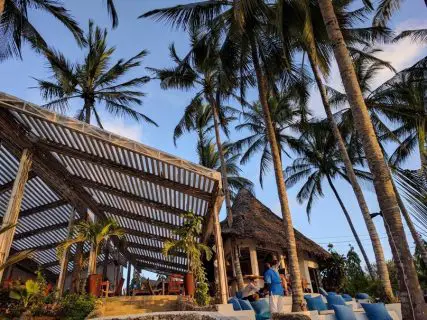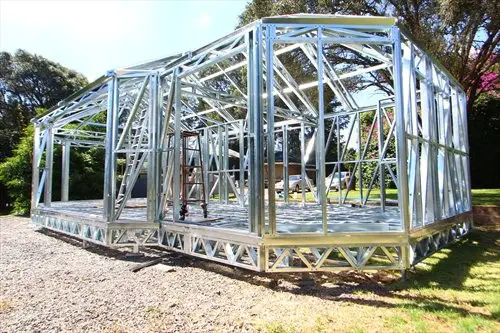Eco-Steel Africa began 9 years ago in East Africa as East African Canvas, having been tent manufacturers for over 20 years and doing luxury tented lodges and camps in different countries around the world.
According to the Director, Monique Brown, they started Eco-Steel Africa to provide an eco-friendly decking solution using light gauge steel as opposed to the popular wood decking used in most projects. They are the first company in East Africa to start working with light gauge steel.
Initially, they had to import all their materials but currently they source about 95 percent of them locally. Most of their projects involve wrapping the steel structures in tents to create beautiful spaces. They deal mainly with offices, workshops, go downs, warehouses and multi-dwelling compounds, offering steel frame design, detailing and construction.
“We mainly work with corporations that need a custom, fast-build structure. We offer a turnkey solution. Clients come to us when they need something fairly quickly and have a specific need that cannot be met by the prefabricated market whose structures are ready made,” Monique says.
“Because we are a custom made-to-fit solution company in what is considered a pre-fabricated building market, we can work with our clients directly from conceptual design to a full build turnkey solution. We design based upon their needs, location and budget whilst offering quality finished products. We also supply the light gauge steel for single, small housing projects,” she adds.
The use of light gauge steel for construction offers a green solution at a time when environmental conservation has become very important in the country. Eco-Steel utilizes a full range of eco-products during construction.
This includes recycled galvanized steel and fiber cement boards. “The recycled materials are up to a minimum of 30 percent.
We also work closely with suppliers of hybrid energy or solar power and waste water solutions,” Monique explains.
The structures are also safe and more accurate compared to traditional buildings especially with a view on the frequent collapsing of buildings in Africa. “We have to go through international engineering design protocol.
The computerized engineering software we use cannot allow you to produce something that has not passed international building standards. There are no shortcuts.” Whenever building using steel, she advises that clients must make sure they are using a light gauge steel supplier that is using proper engineering software.
The steel structures are also an easily movable and transportable solution. “When you have leased an office property and put up the structures, you can move with them whenever your lease expires. Of course you lose a percentage of some of your finishing materials in the process but the actual skeleton steel framework would still be there,” she says.
The speed of putting up the structures is also an endearing factor for clients of Eco-Steel. “We build these structures in a third or half of the time it takes to put up a traditional building. In one of the private camps, we are doing six separate accommodation units for their staff and we are looking to finish in 30 days,” she explains.
They have worked on several projects for lodges, airports, and conservancies in East Africa. The Tented Safari Lodge in Tanzania (Lemala Camps: Grumeti) was the first tented safari lodge to be built entirely from light gauge steel and using a hybrid tented wrap solution for external finishes, with selected hard walls for internal finishing. Other projects include:
Tented Safari Lodge in Tanzania (TGT Mwiba), which was set on the edge of an escarpment, Nanyuki Airport, which is a two-phased build that wraps around the existing airplane hangars, Wilson Airport, which is a two-phased compound build to house helicopters and jet airplanes, pilots’ accommodation, admin centers and medical centers, and the Mara Conservancy where they built three-bedroom cottages for the staff.
“In conservancies and parks, there are very strict building regulations. No structures can be permanent; everything has to be of very low impact to the environment. We put the cottages on stilted light gauge steel structures so there is little foundation work going on. You also need to ensure that the waste water treatment and energy solutions do not affect the environment in terms of waste output or noise pollution. This solution is therefore perfect for those conditions,” Monique says.
The company has also done the Hillcrest Secondary Schools Dormitory Blocks. They constructed a stilted double story structure built with most recycled and eco-friendly building components. “The school wanted to create the first green building solution in Kenya so we worked with about 300, 000 recycled tetra boards for all the internal and external finishing,” she offers. They are currently working on the prototype building phase of tented lodge guest units for a large hotelier in Israel who is building a light gauge steel tented wrap solution.
According to Monique, the major challenge they are facing is introducing people to this new alternative build solution. “Light gauge steel is fairly new in the East African market and we are educating the market on its benefits. More and more of the public is beginning to appreciate the accuracy and innovation of light gauge steel structures,” she says.
In conclusion, she says that with these structures, the word ‘variation’ to contracted works is eliminated. “We build what we quote for with no variations, unless the client adds or changes something to the scope of works. This allows for clients to budget for exact cost especially in multiple unit builds.”

